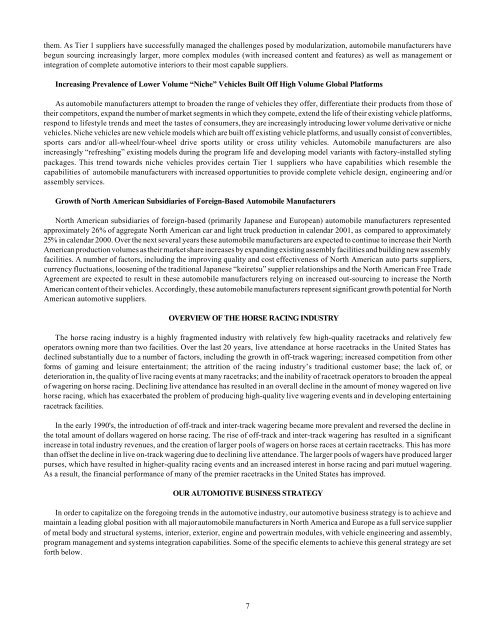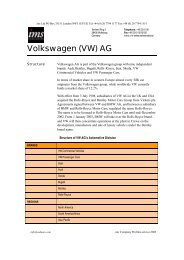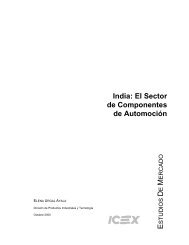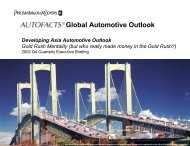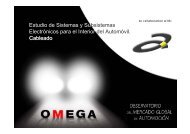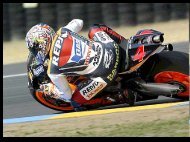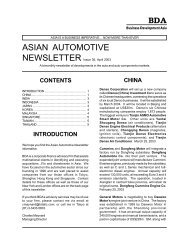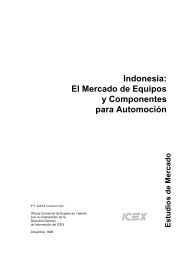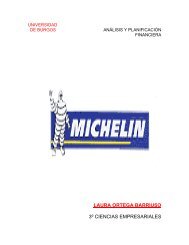Magna International Inc. - OMEGA
Magna International Inc. - OMEGA
Magna International Inc. - OMEGA
Create successful ePaper yourself
Turn your PDF publications into a flip-book with our unique Google optimized e-Paper software.
them. As Tier 1 suppliers have successfully managed the challenges posed by modularization, automobile manufacturers have<br />
begun sourcing increasingly larger, more complex modules (with increased content and features) as well as management or<br />
integration of complete automotive interiors to their most capable suppliers.<br />
<strong>Inc</strong>reasing Prevalence of Lower Volume “Niche” Vehicles Built Off High Volume Global Platforms<br />
As automobile manufacturers attempt to broaden the range of vehicles they offer, differentiate their products from those of<br />
their competitors, expand the number of market segments in which they compete, extend the life of their existing vehicle platforms,<br />
respond to lifestyle trends and meet the tastes of consumers, they are increasingly introducing lower volume derivative or niche<br />
vehicles. Niche vehicles are new vehicle models which are built off existing vehicle platforms, and usually consist of convertibles,<br />
sports cars and/or all-wheel/four-wheel drive sports utility or cross utility vehicles. Automobile manufacturers are also<br />
increasingly “refreshing” existing models during the program life and developing model variants with factory-installed styling<br />
packages. This trend towards niche vehicles provides certain Tier 1 suppliers who have capabilities which resemble the<br />
capabilities of automobile manufacturers with increased opportunities to provide complete vehicle design, engineering and/or<br />
assembly services.<br />
Growth of North American Subsidiaries of Foreign-Based Automobile Manufacturers<br />
North American subsidiaries of foreign-based (primarily Japanese and European) automobile manufacturers represented<br />
approximately 26% of aggregate North American car and light truck production in calendar 2001, as compared to approximately<br />
25% in calendar 2000. Over the next several years these automobile manufacturers are expected to continue to increase their North<br />
American production volumes as their market share increases by expanding existing assembly facilities and building new assembly<br />
facilities. A number of factors, including the improving quality and cost effectiveness of North American auto parts suppliers,<br />
currency fluctuations, loosening of the traditional Japanese “keiretsu” supplier relationships and the North American Free Trade<br />
Agreement are expected to result in these automobile manufacturers relying on increased out-sourcing to increase the North<br />
American content of their vehicles. Accordingly, these automobile manufacturers represent significant growth potential for North<br />
American automotive suppliers.<br />
OVERVIEW OF THE HORSE RACING INDUSTRY<br />
The horse racing industry is a highly fragmented industry with relatively few high-quality racetracks and relatively few<br />
operators owning more than two facilities. Over the last 20 years, live attendance at horse racetracks in the United States has<br />
declined substantially due to a number of factors, including the growth in off-track wagering; increased competition from other<br />
forms of gaming and leisure entertainment; the attrition of the racing industry’s traditional customer base; the lack of, or<br />
deterioration in, the quality of live racing events at many racetracks; and the inability of racetrack operators to broaden the appeal<br />
of wagering on horse racing. Declining live attendance has resulted in an overall decline in the amount of money wagered on live<br />
horse racing, which has exacerbated the problem of producing high-quality live wagering events and in developing entertaining<br />
racetrack facilities.<br />
In the early 1990's, the introduction of off-track and inter-track wagering became more prevalent and reversed the decline in<br />
the total amount of dollars wagered on horse racing. The rise of off-track and inter-track wagering has resulted in a significant<br />
increase in total industry revenues, and the creation of larger pools of wagers on horse races at certain racetracks. This has more<br />
than offset the decline in live on-track wagering due to declining live attendance. The larger pools of wagers have produced larger<br />
purses, which have resulted in higher-quality racing events and an increased interest in horse racing and pari mutuel wagering.<br />
As a result, the financial performance of many of the premier racetracks in the United States has improved.<br />
OUR AUTOMOTIVE BUSINESS STRATEGY<br />
In order to capitalize on the foregoing trends in the automotive industry, our automotive business strategy is to achieve and<br />
maintain a leading global position with all major automobile manufacturers in North America and Europe as a full service supplier<br />
of metal body and structural systems, interior, exterior, engine and powertrain modules, with vehicle engineering and assembly,<br />
program management and systems integration capabilities. Some of the specific elements to achieve this general strategy are set<br />
forth below.<br />
7


